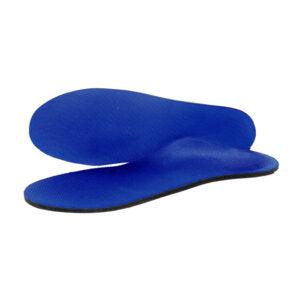If you are experiencing pain or discomfort in your feet or ankle joints, you may have fallen arches. Take a look at the bottom of your feet, you should notice an upward curve in the middle of your feet – this is your arch. A normal arch is an upward curve in the middle of your foot, but if you notice a downward sagging in the inside edge of your foot, you may have fallen arches.
The arch in feet is created by how the tendons in your feet attached the heel to the ball of your foot. When the tendons are weakened, the arches in your feet will begin to fall. This condition is called adult-acquired flat feet, or fallen arches.

Causes of Fallen Arches
There are several reasons why you may have fallen arches. Some are genetic, and some causes are due to outside effects.
- An abnormality that is present at birth
- Stretched or torn tendons
- Damage or inflammation of the posterior tibial tendon, which connects from your lower leg, along with your ankle, to the middle of the arch
- Broken or dislocated bones
- Some health conditions, such as rheumatoid arthritis.
- Nerve problems
Fallen arches are more common in women and people older than 40 years of age. Additional risk factors include obesity, diabetes, and hypertension. If you have played high-impact sports such as basketball, tennis, or soccer, this may have contributed to a torn or stretched tendon.
Common Symptoms of Fallen Arches
Fallen arches are common among many adults, and some notice no problems. But others may experience the following symptoms:
- Pain along the inside of the foot and ankle (in the Achilles tendon or stress in other parts of the heel).
- Pain or swelling of the arches (edema).
- Pain with activities, such as running, jogging, and walking, or whenever you put weight on your foot.
- Knee, hip, and back pain.
As fallen arches become more advanced, the arch flattens even more and pain often shifts to the muscle outside of the foot, below the ankle. Once the tendons have deteriorated considerably, arthritis often develops in the foot because of stress on the bone and on the tibialis posterior muscle. In more severe cases, arthritis may also develop in the ankle.
Diagnosis
You can easily test yourself to see if you might have fallen arches or flat feet. Follow these three steps:
- Get your feet wet
- Stand on a flat surface where your footprint will show, such as on a concrete walkway
- Step away and look at the prints
If you see complete imprints of the bottom of your feet on the surface, then you’re likely to have flat feet. Are you experiencing foot pain and believe you are suffering from fallen arches? We highly recommended that you seek the opinion of a medical professional for the diagnosis and treatment of fallen arches.
Treatment
Most patients can be treated without surgery using orthotics, supportive shoes, and braces. Due to the progressive nature of fallen arches, early treatment is advised, along with a magnetic resonance imaging (MRI) session approved by a physician to seee where the stress on the ligament is coming from. If treated early enough, your symptoms may resolve without the need for orthopedic surgery.
In many cases, treatment can begin with non-surgical approaches that may include:
- Proper stretching exercises.
- Orthopedic devices, shoe modifications, braces, or casts.
- Physical therapy.
- Pain relief medications, such as non-steroidal anti-inflammatories
- Shoe modifications.
Best Exercises for Fallen Arches

Towel Scrunch
- Stand with one foot in the center of a hand towel.
- Scrunch your toes in and straighten them out to bunch the towel as much as possible.
- When you have scrunched the towel, use your feet to stretch the towel back out.
- Repeat on the opposite foot.

Toe Clawing
- Sit up straight in a chair with your feet flat on the ground.
- Scrunch up the toes of one foot as if you are trying to grab hold of the floor then use your toes to drag your foot a small distance forwards.
- Repeat on each foot, but don’t use your leg muscles to push your foot forward — the movement should come solely from the muscles in your feet.

Foot Press and Release
- Sit on the floor with your legs straight out in front of you then bend your knees out to either side. Place the soles of your feet together so your legs form a diamond.
- Hold on to your ankles and, keeping your heels together at all times, separate your feet so your toes point out to either side.
- Open and close your feet in this way several times, making sure your little toes stay in contact with the floor throughout the exercise.
- Starting in the same position, try separating your heels, keeping your toes together at all times.
Best Shoes for Fallen Arches
We carry a wide variety of shoes and sandals for fallen arches. Many of the supportive shoes and sandals we carry have great support and accommodate orthotics. Shoes for fallen arches should have a very rigid sole and a stiff heel counter.
|
|

|
|
|
|

|

|
Shop Shoes for Fallen Arches
Best Arch Supports for Fallen Arches
We have a wide variety of arch supports for fallen arches. The best arch support for fallen arches will control pronation, and be adjustable to meet your foot needs. The best insoles for fallen arches usually are custom-molded and have rear foot postings to help control the amount the arch falls when you take a step. We have over the counter arch supports and custom molded orthotics which help reduce the pain associated with fallen arches. Make an appointment today with a specialist to find out which fallen arch support is best for you!

|
 S3500 |
 S3000 |
|
Shop Arch Supports for Fallen Arches
Shop Lucky Feet Shoes to Help Your Fallen Arches
At Lucky Feet Shoes, we help all types of people improve their foot health with quality footwear, arch supports, custom orthotics and modifications, and accessories. At Lucky Feet Shoes, we carry many plantar fasciitis shoes: sandals, heels, walking shoes, running shoes, casual sneakers, clogs, wedges, flats, booties, and boots. Meet with a fit expert at Lucky Feet Shoes, your professional resource for comfortable, supportive shoes that can help your fallen arches and have you walking, pain-free.
We offer convenient locations across Southern California including Orange County, Los Angeles County, Riverside County, San Bernardino County, and the Inland Empire. Our 8 stores proudly customers from Anaheim, Anaheim Hills, San Dimas, Long Beach, Rancho Cucamonga, Redlands, Riverside, Palm Desert, La Quinta, Temecula, Torrence, Santa Ana, Huntington Beach, Lake Elsinore, Hemet, Menifee, Murrieta, Perris, Moreno Valley, Corona, Norco, El Cerrito, Lakewood, Fullerton, Brea, Chino, Pomona, Ontario, Upland, Rialto, San Bernardino, Covina, West Covina, Chino Hills, Winchester, Fallbrook, Highland, Yucaipa, Garden Grove, and Wildomar.
Come and visit us today!

Jerick Sobie
Since 2005, I have been a dedicated small business owner specializing in footwear retail. With over 20 years of experience, my business partner and I have helped customers find the perfect shoes that combine style, comfort, and quality. Our expertise extends beyond local sourcing—we have traveled internationally to discover high-quality footwear that meets our customers’ needs. In addition to running my business, I have participated in numerous health fairs and educational seminars, sharing my knowledge on proper footwear and foot health. Committed to providing exceptional service, We carefully curate our selections to ensure the best fit and support for every customer.


























